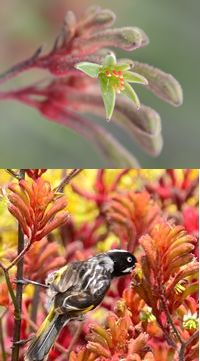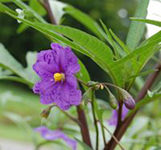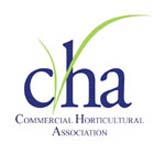We would like to start the New Year by wishing everyone a happy and prosperous 2013. While the omens are not good for a rapid recovery in the world economy there is growing optimism that the triple dip recession has been avoided.
At the end of November two events took place which are worthy of further mention. First on 28 November was the Members' Forum. This event, organised by the Membership Affairs Committee, enables all SCI members to take part in the formulation of the future direction of the Society.
A day later, on 29 November, a conference entitled 'More Crop per Drop' organised by the BioResources Group examined the global issues around water use for crop production. This excellent conference is reviewed by Cath O'Driscoll on page 13 of the January issue of C&I and by Alan Bayliss on page 60 of the same issue.
The Horticulture Group has no events planned for January but interest is developing in the 'Advances in South West Horticulture' event at Cannington on 13 February and our visit to Eccleston Square gardens and the Royal College of Physicians medicinal garden, 'Ceanothus and Medicinal Plants' on 15 March. Please register your interest in these events, by contacting me, if you wish to attend.
Peter Grimbly
Sainsbury's Farming Conference
Last Autumn I received an invitation to attend the Sainsbury's Farming Conference. Why I had been selected I do not know but, as it was being held close to home, I took up the invitation to learn more. On arrival it soon became apparent that the majority of those invited were farmers, growers, processors and marketing organisations who supplied the supermarket.
The meeting started with a presentation from Chief Executive, Justin King who outlined the current view of the supermarket sector. For the first time the supermarket sector had seen its overall profit decline as cost growth outstripped income growth. Despite this he was able to show that Sainsbury's was doing better than just holding its own. Some of their success he put down to having the highest own label penetration. With supermarkets vying to show they are at least equalling the price of their rivals in the current brand war, own labels give more flexibility. 'We don't claim our own label products are the cheapest, we are more concerned with their quality' King stated.
In autumn 2011 shopping habits changed suddenly and permanently with shoppers buying less on each visit but making more frequent visits. The main weekly shop was done at a main store but topped up at a local convenience store. Online shopping was growing and they had noticed that where customers used a combination of a main store, convenience stores and online shopping they spent around twice as much.
Judith Batchelar, Director of Sainsbury's Brands, gave an update on their 20x20 Sustainability Plan: 20 targets they aim to meet by 2020. These cover the whole of their business, with 14 covering food, health, sourcing and environment. More.
As part of this they are offering 14 grants totalling £1.2 million, to individuals and groups for projects to improve their production efficiency.
Product groups: groups of Sainsbury's suppliers in the same product sector, figured prominently. Several reported on the progress made; chatting to some during lunch, it was clear that people were finding them useful in helping their businesses develop. The examples we were presented with all came from the meat and dairy sector. However, the progress being made in all cases was interesting and the over-riding impression from all was the importance of data collection to aid decision making. This extended to the research awards where some were very much based on data collection.
Although the presentations were biased to animal production, when it came to announcing the 14 awards, four were for clearly horticultural projects (6 if you include potatoes). These were:
- Reducing natural gas for CO2 in tomatoes, cucumbers and sweet pepper - Wight Salads
- Using LEDs to extend the strawberry season, Chris Batchelor (Wallings Nursery) and MW Mack
- Dynamic controlled atmosphere storage of apples, Paul Mansfield Mansfields) and Clive Goatham (AC Goatham & Son)
- Benchmarking efficiency in UK glasshouses, Chris Batchelor (Wallings Nursery), Thanet Earth and Wight Salads
- Improved soil and water management of potato
- Non-chemical solutions for potato cyst nematode in Jersey potato.
All in all a most interesting conference and thanks to Sainsbury's for the invitation.
Peter Grimbly
Plant of the Month
Anigozanthos flavidus, (kangaroo paws), Haemodoraceae

This plant is widely cultivated as an ornamental and for cut flowers, not only in Australia. The kangaroo paw has a very vigorous coarse rhizomatous root system, which leads to challenges with containerised production. As well as investigating alternative container types and mechanical root pruning, there have been several publications on the use of chemical means to root prune these plants. Cobalt carbonate appears to offer potential.
Birds that come to feed on the sugary nectar produced by the flowers pollinate the kangaroo paw flowers. The nectar is a mixture of glucose and fructose derived from sucrose. There are many fine examples of these plants at the Australian Garden and Royal Botanic Gardens Cranbourne, Australia. (Pictures by Alison Foster)
Alison Foster
Oxford Botanic Garden
Medicinal Plant of the Month

Solanum is a very economically important genus containing such crops as potatoes, tomatoes, aubergine as well as many poisonous species. The kangaroo apple, Solanum laciniatum (picture right by RI), is poisonous, but has medicinal value, due to the biological activity of the natural products it contains.
This small shrub is native to the temperate regions of New South Wales, Australian Capital Territory, Victoria, South Australia, Tasmania and New Zealand and is often used as a fast growing screen plant. It has been used as a bush medicine, with the fruit being made into a poultice and put on swollen joints.

Alison Foster
Oxford Botanic Garden
News from our Associates
Commercial Horticultural Association

Horticulture Industry News
For the very latest horticultural news follow us on Facebook and Twitter.
How plant organs form, a breakthrough
Plant growth and development is regulated by internally produced chemical signals, including hormones like brassinosteroid, which is found throughout the plant kingdom. The brassinosteroid signaling pathway is involved in regulating more than 1,000 plant genes. Mutant plants that are deficient in brassinosteroid, that are grown in the dark, show features of plants grown in the light. They also have defects at many phases of the plant life cycle, including reduced seed germination, dwarfism, and sterility.
A new study has uncovered yet another role for brassinosteroid: the formation of boundaries between organs. Plants made hypersensitive to brassinosteroid displayed fused organs. The study showed that activation of the brassinosteroid pathway represses a group of genes called the cup-shaped cotyledon, or CUC family, which is responsible for organ boundary formation. More
Global partnership to develop and market red-flesh apples
Twelve leading fruit marketers, from five continents, are joining forces to perfect red-flesh apples and bring the exciting new varieties to market within five years. The marketers came together near Angers, France, in October to create IFORED, an international consortium that will test, select and commercialize red-flesh apple varieties.
IFORED will immediately begin developing a promising set of varieties created by International Fruit Obtention (IFO), a French company dedicated to developing new apple varieties. 'We see tremendous potential for red-flesh apples,' said Bruno Essner, President of the IFORED Board of Directors. 'We have put together a marvelous group of experienced growers and marketers from across the world to harness this potential and to bring distinct apple varieties to market'. More

Asparagus is more generally renowned for its reputed aphrodisiac properties. However, scientists now believe it could ward off the effects of a hangover. They have found chemicals in the vegetable which protect liver cells against toxins. The minerals and amino acids in asparagus can replace those lost through alcohol consumption, which can often lead to a headache. They also relieve stress on the liver. But for the greatest effect it is recommended to serve the leaves as well as the tender shoots. More
Rising greenhouse gas gives giant sweet potatoes
Rising levels of carbon dioxide (CO2) in the atmosphere might lead to larger sweet potatoes, a staple food for many African and Asian countries. Sweet potatoes could double in size with the increase in CO2 levels currently forecasted for the end of this century, according to a Hawaii research team. They grew a white-fleshed sweet potato variety found in Hawaii in two types of fertiliser at current CO2 levels of 352 parts per million (ppm), as well as in three raised CO2 environments: 763, 1,108 and 1,515 ppm. Even at 763 ppm of CO2, the tubers grew up to 96 per cent larger. According to the Intergovernmental Panel on Climate Change, atmospheric CO2 levels will be between 500 and 1,000 ppm by the year 2100, so we could definitely see many more giant sweetpotatoes in the future. More
Some grasses predisposed to evolve C4 photosynthesis
C4 photosynthesis is a series of anatomical and biochemical modifications to the typical C3 pathway that increases the productivity of plants in warm, sunny, and dry conditions. Despite its complexity, it evolved independently more than 62 times in flowering plants. However, C4 origins are absent from most plant lineages and clustered in others, suggesting that some phylogenetic groups contain characteristics that predispose them to C4 evolution. The C4 trait has evolved 22-24 times in grasses, all within the PACMAD clade which includes maize, sorghum and sugar cane. The similarly sized BEP clade, which includes wheat, barley, rice, millet and bamboo, contains only C3 taxa.
Statistical modeling indicates that C4 evolvability strongly increases when the proportion of vascular bundle sheath (BS) tissue is higher than 15%, resulting from a combination of large BS cells and a short distance between BSs. A reduction in the distance between BSs occurred before the split of the BEP and PACMAD clades, but a decrease in BS cell size later occurred in BEP taxa. Therefore, when environmental changes promoted C4 evolution, suitable anatomy was present only in members of the PACMAD clade, explaining the clustering of C4 origins in this lineage. More
Whole plant therapy an effective and economical treatment for malaria?
A new study has shown that the powdered dried leaves from the Artemisia annua plant may be a far more effective antimalarial treatment than purified artemisinin. It delivers 40 times more artemisinin to the blood and reduces the level of parasite infection more completely in mice. The effectiveness of the whole plant, may be due, in part, to the presence in Artemisia annua leaves of other compounds, including flavonoids also known to have antimalarial abilities, which may work synergistically to combat the parasite and ward off resistance. Using the dried whole plant, instead of purified artemisinin, could significantly lower the cost of treating malaria, since it would eliminate the need to extract the drug from the plant and purify it, and could greatly expand access to antimalarial therapy. More
Plants sniff out danger and prepare their defences against insect attack
Once tall goldenrod plants (Solidago altissima) smell a sex attractant emitted by true fruit fly males, they appear to prepare chemical defences that make them less appealing to female flies that could damage the plants by depositing eggs on them. A tall goldenrod plant's reaction to these odours also appears to make it less attractive to other insects that might feed on it, according to researchers. In a field study, they exposed some plants to the odour of the male fly and then counted the number of exposed and unexposed plants on which female flies laid eggs. Female flies were significantly less likely to lay eggs on plants exposed to the male emission and about four times more likely to lay eggs on plants in a control group that were not exposed to this odour cue.
Turning up the heat on plant sex
It has been long-noted that some plants do not engage in the gene-swapping meiotic processes as others did. In cereals, in particular, certain chromosomal regions do not crossover very much. Researchers found 12-19 crossovers per cell (spread across all chromosomes) and 1-3 crossovers per chromosome. However, crossovers were 25 times more likely at the ends of chromosomes compared to the middle.
The story that began to emerge was that the initiation of recombination does occur throughout the length of the chromosome - but it's all a matter of timing. The process begins two-to-three hours earlier at the end of chromosome and works to the middle. This process seems to be affected by the chromatin surrounding the DNA strands and further experiments show that small increases in temperature blur the timing of the onset of recombination. This increases the frequency of crossovers in the centre of the chromosome and alters the variation in the offspring on which plant breeders and natural selection work.
Car tyres made from dandelions

The advantage of TKS over other plants is that it has a wide climatic tolerance, can be grown as a short term or even annual crop, and harvested and processed mechanically. This enables it to be farmed according to need, which tree-sourced rubber cannot. More
Events Calendar
Other Events of Interest
International Crop Science Conference & Exhibition
6 Jan 2013 - 9 Jan 2013, Pesticide Manufacturers Association of India
Nairobi, Kenya
International Symposium on Human Health Effects of Fruits and Vegetables
7 Jan 2013 - 11 Jan 2013, International Society for Horticultural Science
Dharwad, India
International Soft Fruit Conference
10 Jan 2013, BVB Substrates & DLV Plant
's-Hertogenbosch, The Netherlands
The Impact of Farming, Urbanisation and Alien Planting on Biodiversity
17 Jan 2013, Bristol Botanic Garden
Bristol, UK
IPM Essen
22 Jan 2013 - 25 Jan 2013, Messe Essen, see also Commercial Horticultural Association
Essen, Germany
British Herb Trades Association Annual Conference
26 Jan 2013, British Herb Trades Association
Warwick, UK
BPOA AGM and Conference
6 Feb 2013, British Protected Ornamentals Association
Oxford, UK
Fruit Logistica
6 Feb 2013 - 8 Feb 2013, Messe Berlin, see also Commercial Horticultural Association
Berlin, Germany
Lanscape Industry Show
13 Feb 2013 - 14 Feb 2013. California Lanscape Contractors Association
Los Angeles, USA
Salon du Vegetal
19 Feb 2013 - 21 Feb 2013, Bureau Horticole Régional, see also Commercial Horticultural Association
Angers, France
New Technologies for Sustainable Agricultural Production and Food Security
24 Feb 2013 - 26 Feb 2013, International Society for Horticultural Science
Muscat, Oman
Environmental Management & Crop Protection
25 Feb 2013 - 26 Feb 2013, Association for Crop Protection in Northern Britain
Dundee, UK
Poland - Chance or Challenge
2 March 2013 - 9 March 2013, Under 40s Fruit Growers Tour
Poland
New AG International
13 Mar 2013 - 15 Mar 2013, New AG International
Rio de Janeiro, Brazil
Pesticide Use and Risk Reduction for Future IPM in Europe
19 March 2013 - 22 March 2013, Fondazione Edmund Mack, Pure, Laimburg
Riva del Garda, Italy
From Farm to Fork - Plant Molecular Breeding and Post-harvest Research in the 21st Century
23 March 2012, PlantLink, Food Technology at Lund University and Department of Plant Breeding
Lund, Sweden
Crop Resource Use Efficiency and Field Phenotyping
25 Mar 2013 - 26 Mar 2013, Association of Applied Biologists
Grantham, UK
Middle East Horticultural Summit
26 Mar 2013, International Society for Horticultural Science
Dubai
Temperate Zone Fruits in the Tropics and Subtropics
26 Mar 2013 - 28 Mar 2013. International Society for Horticultural Science
Chiang Mai, Thailand
Flowers & Hortech, Ukraine
9 Apr 2013 - 11 Apr 2013, BTO Exhibitions
Kiev, Ukraine
UK PlantSci
16 April 2013 - 17 April 2013, UK Plant Science Federation
Dundee, UK
IFST Spring conference 2013: Securing the Future Supply of Food
17 Apr 2013, Institute of Food Science & Technology
Norwich, UK
Grapevine Physiology and Biotechnology
26 Apr 2013 - 26 Apr 2013, International Society for Horticultural Science
Santiago, Chile
Discovery and Development of Innovative Strategies for Post-harvest Disease Management
29 Apr 2013 - 2 May 2013, International Society for Horticultural Science
Kusadasi, Turkey
If you would like to advertise a forthcoming event please contact. charne.green@soci.org
Horticulture Group Contact Details
For submitting ideas or to volunteer to be part of a committee or a group, please contact:
Chairman - Peter Grimbly
Meetings Secretary - Alison Foster
Minutes Secretary - Margaret Waddy
Newsletter co-ordinator - Sue Grimbly scihortigroup@btinternet.com
Group Contact - Charne Green charne.green@soci.org T: +44 (0)20 7598 1594
